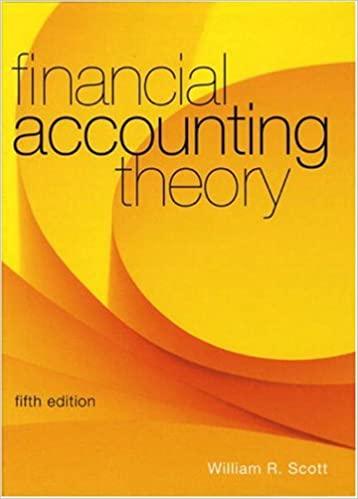Under IAS 39 and SFAS 115, most loan assets held by banks are held in the loans
Question:
Under IAS 39 and SFAS 115, most loan assets held by banks are held in the loans and receivables or held-to-maturity categories, where they are valued at amortized cost. Of course, if the fair value of a loan should fall below this amount, the impaired loans standards require a write-down. Following the 2000 economic downturn, investors watched loan write-downs with particular care. Major write-downs will likely result in a decline in the bank's share price, as investors interpret the write-down as a sign of loan quality problems to come. For example, in Canada, The Globe and Mail, March 7, 2001, reported “Scotiabank profit overshadowed by impaired loans.” The bank reported a substantial increase in first quarter, 2001, net income. However, it also reported a 44% increase in impaired loans.
Its share price on the Toronto Stock Exchange fell by $3.46, closing at $42.44.
Faced with reactions such as these, banks may wish to disguise the extent of major loan write-downs. An article in The Economist, March 22, 2001, “Shell game,” describes how some U.S. banks have responded to similar situations.
The trick, according to The Economist, is to transfer problem loans to the available-for sale category. Under SFAS 115, available-for-sale securities are valued at their fair value.
Thus, the transferred loans must be written down. However, the write-down will be buried in larger totals and the market would not know how much of the total adjustment to fair value belongs to the loans transferred. Furthermore, unrealized gains and losses from fair valuing available-for-sale securities are included in other comprehensive income under SFAS 115, so that write-downs do not affect net income. Another consequence is that the book value of held-to-maturity loans on the balance sheet is reduced, so that any existing loan loss allowance will appear more adequate.
Whether banks actually sell the transferred problem loans s an open question. The Economist points out that the dollar amount of secondary trading has risen dramatically in recent years. However, the length of time that banks can hold loans in the available for-
sale category without selling them is a “grey area.” Presumably, the banks’ auditors will be aware of these practices and will take steps to discourage them. However, The Economist quotes an official of the Office of the Comptroller of the Currency (a U.S. banking regulator) as saying auditors “too often side with their clients” in grey areas.
Required
a. What is the likely effect on banks’ share prices and on the operation of capital markets of the above practice? Explain.
b. Why do IAS 39 and SFAS 115 allow loans and receivables and held-to-maturity loans to be valued at cost, or amortized cost, instead of at fair value like held for trading and available-for-sale securities? To what extent would amending these standards to require fair value accounting for all financial instruments be feasible? Explain.
c. If you were the auditor of a bank engaging in the above practice, would you qualify your audit report if the bank refused your request to stop? Discuss why or why not. In your answer, consider both principles of ethical behavior and your own reputation and economic well-being.
Step by Step Answer:






